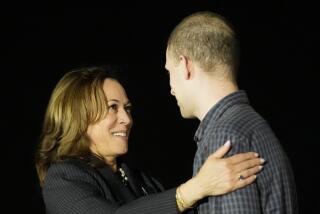Releasing Iranâs Assets: A Bid to Free U.S. Hostages
WASHINGTON â The U.S. decision to free $575 million in Iranian assets was the first product of a concerted behind-the-scenes effort by the Bush Administration to settle issues that could stand in the way of a possible hostage release, Administration officials said Tuesday.
But Administration officials warned that there have been numerous false alarms in the past about hostage releases, and many issues remain to be resolved before any of the eight Americans held captive in Lebanon will be freed.
Even so, there are some hopeful signs. Over the weekend, after the agreement on the $575 million was reached, the governmentâs hostage task force was alerted to prepare for a short-notice trip to Frankfurt, West Germany, in the event a hostage might be freed in Lebanon by pro-Iranian Shiite Muslims.
Although rumors of hostage releases are âa dime a dozen,â in the words of one Administration official, alerts to the hostage team are not. Last weekendâs notification was the first so far this year, and there was only one in 1988. The alert came after a third-party European intermediary told U.S. officials that a hostage--no name was given--might be released.
Officials denied that the release of the money was part of any deal for the hostagesâ freedom, but they conceded that the two issues cannot be wholly separated.
âNothing we do with a country like Iran happens in a vacuum,â said a senior State Department official. âIf we get the causes of tension resolved, then maybe weâll also get the products of tension resolved.â
Officials said that Bush personally directed the State Department several months ago to try to expedite settlements of continuing disputes over Iranian assets, which Iranâs leaders have often cited as an issue that must be resolved before the hostages are released.
âIâd like to get this underbrush cleaned out now,â Bush said in his press conference Tuesday. He added, however, that he cannot be sure how Iran will respond. âOf course, I hope Iran will use what influence it has to get these hostages released,â he said.
Officials cautioned that the extent of Iranian influence is untested. Four separate Lebanese extremist groups hold the eight American hostages, and each of the small groups has its own set of demands.
The return of Iranâs assets has been a chief demand of Iranian leaders. On Oct. 23, Iranian President Hashemi Rafsanjani said Iran would help gain release of the hostages, but only if the United States returned frozen Iranian assets.
âIf the Iranians want to read this as a signal, itâs fine with us,â a State Department official said. âThe interpretation will be in the eyes of the beholder.â
Fridayâs decision was reached after two days of negotiations in The Hague between Abraham Sofaer, the State Departmentâs legal counsel, and Iranian officials. How far it will go toward meeting Iranâs desires remains unclear.
The $575 million is roughly half the money that has been kept in bank accounts under the jurisdiction of the U.S.-Iran Claims Tribunal, based in The Hague. That money is all that remains of nearly $10 billion in Iranian assets impounded by the Carter Administration after Iranian militants seized the U.S. Embassy in Tehran a decade ago.
Most of the impounded funds were returned to Iran long ago or distributed to banks and other companies with claims against the Iranian government. The $575 million was being kept as security for claims raised by banks involved with loans to the Iranian government. Because all but one of those claims has now been settled, the money probably would have been returned to Iran sooner or later even without an agreement.
On the other hand, billions more are at stake in a host of lawsuits that the claims tribunal is considering. The largest case is Iranâs suit against the United States, asking compensation for military equipment paid for but not delivered during the reign of the late Shah Mohammed Reza Pahlavi. The United States concedes that it owes Iran some money for that equipment, but lawyers for both sides have been haggling for years over how much.
There has been no progress recently on resolving that claim, a State Department official said. âItâs unclear to usâ whether the Iranians include resolving that claim when they refer to settling assets issues, the official added.
The $575 million remains symbolically important, however. It is the largest amount transferred to Iran since the claims tribunal was set up in 1981 and a signal of cooperation between the two nations.
The money came from an $818-million fund being held in reserve to cover claims against Iran by banks. That fund will now be closed and the balance, $243 million, moved into a second account that serves as security for other claims against Iran. Iran is required to keep that fund at no less than $500 million, replenishing it as money is drawn out to pay judgments or settlements.
More to Read
Sign up for Essential California
The most important California stories and recommendations in your inbox every morning.
You may occasionally receive promotional content from the Los Angeles Times.











